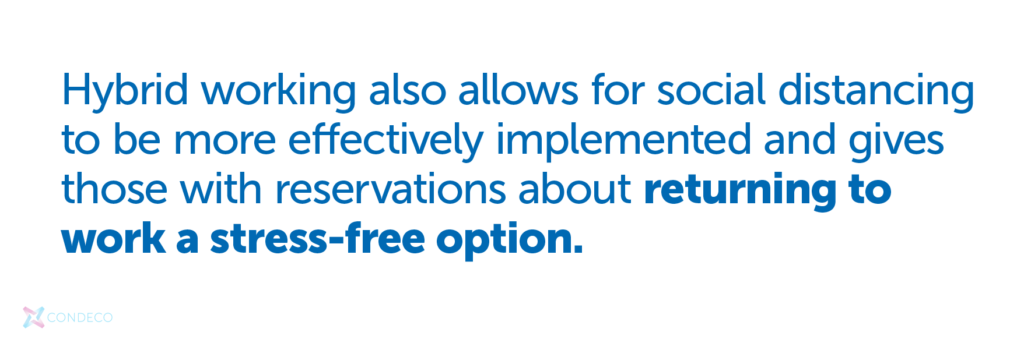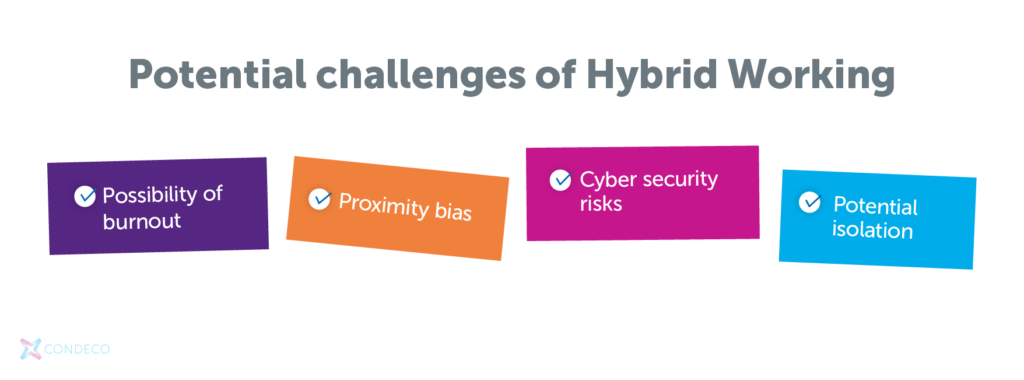
The hybrid work model is being adopted by more and more employees for a very good reason – it makes their business more productive and successful. But it’s not just the CFO who can see the advantages of an organization where people have the certainty and capacity to choose when and where they want to work and collaborate. Employees are also finding that the hybrid model is allowing them to get work done more effectively and enjoy the lifestyle they want.
If you’re still unsure whether hybrid work is right for your employees, we want to summarize its advantages but also make sure you know about the pitfalls to avoid.
Hybrid means happier people
Work-life balance is one of the strongest factors in job satisfaction. It means an enhanced ability to care for children or other family members. Interests outside of work can be pursued more easily and dentist appointments can be arranged at a time that isn’t at either end of the working day. If you want to improve employee retention and recruitment then the hybrid work model may well be the way forward as people fit their duties around their life and not the other way round.
Increased productivity

Numerous studies have shown that people feel just as productive – if not more – when working remotely compared to in an office. Simply having the ability to avoid the daily commute can add extra hours to the day of everyone which can be used more effectively to the advantage of your business. Productivity doesn’t necessarily come from working at home but visits to the office become far more useful when planned properly and the quality of work is improved through effective collaboration. Rather than spending the day answering emails, employees can use tech tools to collaborate and strategize together, giving them a break from intense solo work at home.
Everyone saves money
At a time when the cost of living is rising fast, the savings provided by the hybrid work model benefit both the business and employees. Offices can be smaller and cost less to run. The right tech allows you to monitor the numbers using your office and plan for the optimum space. Employees will no longer have to use gas pumps or train tickets to reach a destination on the days when they could easily work from home. In effect, it’s a pay rise for all.
Team spirit

The old model of everyone in the same building from 9-5 inevitably led to conflict. Seeing people every day can be stressful and, because we’re all human, personal likes and dislikes build up over time that can lead to tensions in the team. Hybrid home working provides an escape valve from this daily experience. People can focus on their job at home rather than deal with personal issues in the office. Absence also makes the heart grow fonder and seeing people less means the time spent with them is more valued. A positive and collaborative culture can be encouraged through technology that ensures the right people are in the right office at the right time.
Better health and safety
Covid is likely to be a part of our lives for years to come and, no matter the infection rate, many people have been scarred by the experience and feel nervous about sharing small spaces with lots of people at the same time. Hybrid working also allows for social distancing to be more effectively implemented and gives those with reservations about returning to work a stress-free option. Who knows, even the annual office flu may no longer be passed around your entire workforce?

Making days more effective
Implemented properly with the right support, hybrid work allows for specific tasks and projects to be undertaken on certain days – when all the right team members are in one place – and other days can be dedicated to completing solo tasks or those that require more focus. The result is an increase in employee productivity, better results and job satisfaction.
A few words of caution
As with anything, the hybrid work model is not without its challenges. None of these are insurmountable but should always be considered if you want your employees to love working at your company.

- Possibility of burnout – working and relaxing in the same place (ie the home) can blur lines and make it difficult to switch off. Especially if people lack the discipline to turn off their computers at the right time. Promote the office as a place to be creative and catch up with colleagues, encouraging a more varied worklife.
- Potential isolation – we’re social creatures and many enjoy the chat and gossip of office life. Those working remotely could suffer from a lack of interaction which leads to isolation. Once again, the solution is to make the office a place to enjoy visiting rather than a duty that has to be faced now and then.
- Cyber security risks – your IT experts have a harder job with hybrid working. Ensuring everyone’s home setup is cyber-secure will require careful planning and training for staff to ensure sensitive data isn’t leaked or lost. A backup plan will also need to be in place as a contingency.
- Proximity bias – don’t make your office the place to go for a promotion. Proximity bias refers to the idea that workers are better perceived when they physically work closer with those in charge. Make sure employees are aware that working from home is just as acceptable as working in the office and everyone is on a level playing field.
As we said, the drawbacks of the hybrid working model are real but can be addressed with some planning and thought. The end result is certainty about the system in place, better collaboration and greater capacity for an organization that can optimize its office space. These advantages are so strong that it’s well worth your time investing a little time and money into getting it right and ensuring you have happy employees and a productive business.



